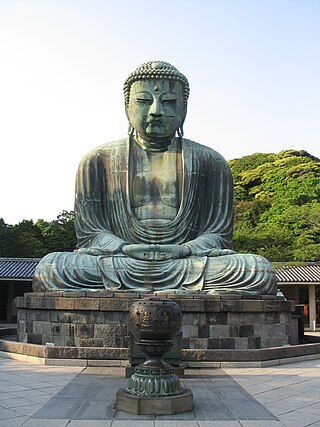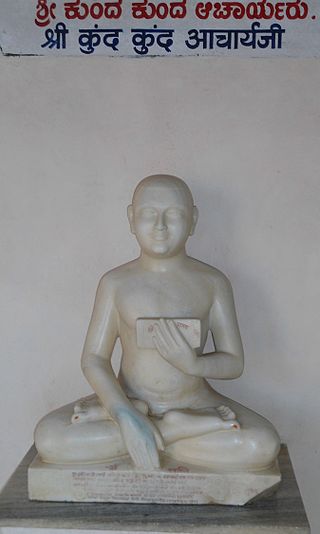Jainism, also known as Jain Dharma, is an Indian religion. Jainism traces its spiritual ideas and history through the succession of twenty-four tirthankaras, with the first in the current time cycle being Rishabhadeva, whom the tradition holds to have lived millions of years ago, the twenty-third tirthankara Parshvanatha, whom historians date to the 9th century BCE, and the twenty-fourth tirthankara Mahavira, around 600 BCE. Jainism is considered an eternal dharma with the tirthankaras guiding every time cycle of the cosmology. The three main pillars of Jainism are ahiṃsā (non-violence), anekāntavāda (non-absolutism), and aparigraha (asceticism).
Nirvana is a concept in Indian religions, the extinguishing of the passions which is the ultimate state of soteriological release and the liberation from duḥkha ('suffering') and saṃsāra, the cycle of birth and rebirth.

Saṃsāra is a Pali and Sanskrit word that means "wandering" as well as "world," wherein the term connotes "cyclic change" or, less formally, "running around in circles." Saṃsāra is referred to with terms or phrases such as transmigration/reincarnation, karmic cycle, or Punarjanman, and "cycle of aimless drifting, wandering or mundane existence". When related to the theory of karma it is the cycle of death and rebirth.
In Buddhism, the term anattā or anātman is the doctrine of "non-self" – that no unchanging, permanent self or essence can be found in any phenomenon. While often interpreted as a doctrine denying the existence of a self, anatman is more accurately described as a strategy to attain non-attachment by recognizing everything as impermanent, while staying silent on the ultimate existence of an unchanging essence. In contrast, dominant schools of Hinduism assert the existence of Ātman as pure awareness or witness-consciousness, "reify[ing] consciousness as an eternal self."

Mahavira, also known as Vardhamana, the 24th Tirthankara of Jainism. He was the spiritual successor of the 23rd Tirthankara Parshvanatha. Mahavira was born in the early 6th century BCE to a royal Jain family of ancient India. His mother's name was Trishala and his father's name was Siddhartha. They were lay devotees of Parshvanatha. Mahavira abandoned all worldly possessions at the age of about 30 and left home in pursuit of spiritual awakening, becoming an ascetic. Mahavira practiced intense meditation and severe austerities for twelve and a half years, after which he attained Kevala Jnana (omniscience). He preached for 30 years and attained moksha (liberation) in the 6th century BCE, although the year varies by sect.

Impermanence, also known as the philosophical problem of change, is a philosophical concept addressed in a variety of religions and philosophies. In Eastern philosophy it is notable for its role in the Buddhist three marks of existence. It is also an element of Hinduism. In Western philosophy it is most famously known through its first appearance in Greek philosophy in the writings of Heraclitus and in his doctrine of panta rhei. In Western philosophy the concept is also referred to as becoming.

Indian philosophy consists of philosophical traditions of the Indian subcontinent. The philosophies are often called darśana meaning, "to see" or "looking at." Ānvīkṣikī means “critical inquiry” or “investigation." Unlike darśana, ānvīkṣikī was used to refer to Indian philosophies by classical Indian philosophers, such as Chanakya in the Arthaśāstra.
Ātman, attā or attan in Buddhism is the concept of self, and is found in Buddhist literature's discussion of the concept of non-self (Anatta). Most Buddhist traditions and texts reject the premise of a permanent, unchanging atman.

In Jainism, a Tirthankara is a saviour and supreme spiritual teacher of the dharma. The word tirthankara signifies the founder of a tirtha, a fordable passage across saṃsāra, the sea of interminable birth and death. According to Jains, tirthankaras are the supreme preachers of dharma, who have conquered saṃsāra on their own and made a path for others to follow. After understanding the true nature of the self or soul, the Tīrthaṅkara attains kevala jnana (omniscience). A Tirthankara provides a bridge for others to follow them from saṃsāra to moksha (liberation).

Ajivika is one of the nāstika or "heterodox" schools of Indian philosophy. Believed to have been founded in the 5th century BCE by Makkhali Gosāla, it was a Śramaṇa movement and a major rival of Vedic religion, early Buddhism, and Jainism. Ājīvikas were organized renunciates who formed discrete communities. The precise identity of the Ājīvikas is not well known, and it is even unclear if they were a divergent sect of the Buddhists or the Jains.

Parshvanatha, or Pārśva and Pārasanātha, was the 23rd of 24 Tirthankaras of Jainism. He gained the title of Kalīkālkalpataru.

A śramaṇa is a person "who labours, toils, or exerts themselves for some higher or religious purpose" or "seeker, one who performs acts of austerity, ascetic". The śramaṇa tradition includes primarily Jainism, Buddhism, and others such as the Ājīvika.
Anekāntavāda is the Jain doctrine about metaphysical truths that emerged in ancient India. It states that the ultimate truth and reality is complex and has multiple aspects.

Buddhism, also known as Buddha Dharma and Dharmavinaya, is an Indian religion and philosophical tradition based on teachings attributed to the Buddha, a wandering teacher who lived in the 6th or 5th century BCE. It is the world's fourth-largest religion, with over 520 million followers, known as Buddhists, who comprise seven percent of the global population. Buddhism originated in the eastern Gangetic plain as a śramaṇa–movement in the 5th century BCE, and gradually spread throughout much of Asia. It has subsequently played a major role in Asian culture and spirituality, eventually spreading to the West beginning in the 20th century.

Brahmā is a leading God (deva) and heavenly king in Buddhism. He is considered as a protector of teachings (dharmapala), and he is never depicted in early Buddhist texts as a creator god. In Buddhist tradition, it was the deity Brahma Sahampati who appeared before the Buddha and invited him to teach, once the Buddha attained enlightenment.

The Buddha is considered the ninth avatar among the ten major avatars of the god Vishnu, according to the Vaishnava tradition of Hinduism.
Jainism is a religion founded in ancient India. Jains trace their history through twenty-four tirthankara and revere Rishabhanatha as the first tirthankara. The last two tirthankara, the 23rd tirthankara Parshvanatha and the 24th tirthankara Mahavira are considered historical figures. According to Jain texts, the 22nd tirthankara Neminatha lived about 84,000 years ago and was the cousin of Krishna.

Digambara is one of the two major schools of Jainism, the other being Śvetāmbara (white-clad). The Sanskrit word Digambara means "sky-clad", referring to their traditional monastic practice of neither possessing nor wearing any clothes.
Anātman in Sanskrit means that "which is different from atman" or "non-self". In Hinduism, the former definition is found in some texts, while in Buddhism, anātman or anattā means non-self.
Jainism and Hinduism are two ancient Indian religions. There are some similarities and differences between the two religions. Temples, gods, rituals, fasts and other religious components of Jainism are different from those of Hinduism.




























